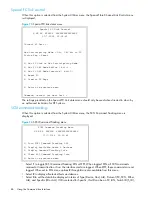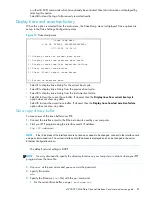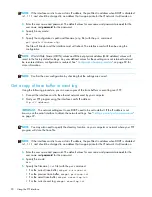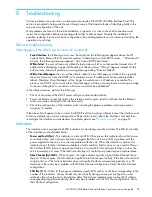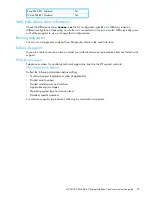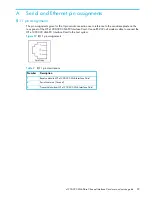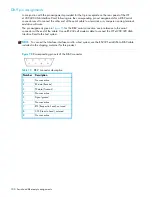
94
Troubleshooting
•
Ethernet (10/100)
—When lit, these green indicators signify Ethernet link status and activity. If either of
these indicators fail to flicker, or stay continuously lit, there may be a problem with the network
connection or configuration. Verify the network connection and configuration. The port must be
connected to a Ethernet network to function properly.
•
Beacon
—This blue indicator can blink or light continuously for unit identification or other management
purposes that are described in more detail in the user documentation for the library management
system.
Basic verification
Serial port problems
If you experience trouble communicating with the serial port, verify the configuration of the host terminal
or terminal emulation program. The interface card requires the baud rate to be set correctly: 8 data bits,
1 stop bit, and no parity. Flow control should be set to none or
XON/XOFF
, and may cause problems if
set to
hardware
. Some terminal programs may not support baud rates higher than 19200, so a lower
baud rate may be required. If problems persist, you may want to check the cabling or try a different host.
Be sure the Scroll Lock key on the keyboard of the host computer is not enabled. If a valid Ethernet IP
address is configured, serial configuration settings can also be set via telnet.
Login problems
In a switched fabric environment, if a login problem is experienced, or if the drives can not be seen,
confirm that the port settings of the interface card are set for
auto-sense
or for
N-port
. Using a hard ALPA
setting with the N-port setting is not a valid configuration.
Windows driver
There are no actual device drivers required for the interface card. When Windows prompts for a device
driver, this situation occurs because the Active Fabric LUN of the interface card is enabled. Solutions to
this request for a driver include the following options:
•
Disable Active Fabric (or the target LUN for the interface card, in order to eliminate further Windows
driver requests. You can also accept the Windows prompts and disable the device in the device
manager.
•
Optionally, an HP device driver installation file (called an INF file) is included on the User
Documentation CD. The interface card does not really need an actual driver, as the HBA in the host
PC manages this. However, the included INF file does allow the Windows Device Manager to register
the interface card’s interface card LUN as a system device. Thereafter, the Device Manager will no
longer consider this interface card LUN to be an unknown or “newly discovered” device every time
there is a reboot. By using the included INF file, the user just needs to identify the interface card to the
Windows Device Manager only once.
To install (or register) the interface card to a connected host Windows PC, perform the following steps:
1.
Copy the INF file to the Windows PC which has the FC HBA to be connected to the interface card.
Typically, the appropriate location to copy the file is as follows:
C:\WINNT\system32\
NOTE:
There must be an interface card LUN set up on the interface card so that the Windows operating
system can discover it.
2.
When the interface card
FC Link
LED indicates a good connection, the user can either reboot the PC or
run the Windows Device Manager
Scan for New Hardware
function. Either action should result in the
HBA issuing a SCSI Inquiry command, to which the interface card replies with an ASCII Inquiry string.
NOTE:
Initially, the Windows Hardware Wizard uses this string to refer to the interface card. After this
discovery interaction occurs, the Hardware Wizard will prompt the user to install a device driver.
Summary of Contents for StorageWorks e1200-320
Page 26: ...26 Device management ...
Page 30: ...30 Interface card management ...
Page 92: ...92 Using the FTP interface ...
Page 98: ...98 Troubleshooting ...
Page 102: ...102 Serial and Ethernet pin assignments ...
Page 108: ...108 Regulatory compliance and safety ...
Page 122: ...122 Enabling DHCP on the HP e1200 320 4Gb FC Interface Card ...







